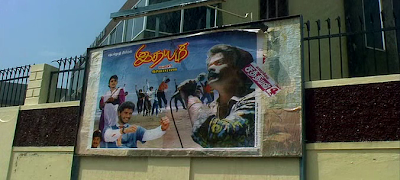Myshkin is consciously working towards positioning himself as an auteur (atleast semi-auteur) in the tamil filmdom. All his films so far, were able to garner a decent commercial as well as critical acclaim. His films, though are flawed in several aspects, are constructed with a conscious rationale. His storytelling with "symbols" and innovative (read as abstract) shots only resound his potential. Even with flawed cinema, the relevance of his works is very much justified in the present day tamil cinema.
Tamil Cinema's confrontations with issues related to love and lust are here to stay. Myshkin however supplies a novel theme to this filmdom to exploit & abuse the already-pounded-to-death female sexuality - the peepshow. We are not exactly sure if this so-called "peepshow" is so much rampant in a normal Indian society but, when people (film directors) are on a search to bring in a new act of sexual perversion/ sexual deviance to garner that ever-important exploitative value to their films, days are not far, for Necrophilia to be treated in a tamil cinema. With so many films on gender, sexuality, exploitation, rape, karpu - so much of opportunity has been lost in communicating any kind of mature feminist perspective and again & again, it boils down to adultery - justification-for-revenge - lectures-for-audience dramas.
Yudham Sei is a crazily convoluted movie (probably with an intention). For about three-fourths of the runtime, you are anxiously trying to assimilate the big-list of names, facts and details that are thrown at you - Rajamanickam, Thirisangu, Isakimuthu, Moorthy, policemen, commissioner office, auto-driver, dance-class etc. Is everyone in the audience a CID officer ?. Cinema works with the audience as they identify - the character, his/ her name (if neccessary), the actor who play the character - all the three. When you get introduced to a character via a dialogue only, that "association" goes missing and hence, instead of getting involved with the narrative, you keep thinking who-is-who ?. There is a difference between "gripping" and "confusing", In both the cases, the audience will follow the narrative closely. There is simply so much of action going on - A couple of crime investigations are on, several pairs of amputated hands were displayed in public places on carton boxes, girls go missing, Cheran is roaming around like a loser, his sister is also missing, film is shot in the night time, auto drivers, several oldmen discussing "show" etc etc. "Yudham Sei" is confusing (before everything will be clarified in a flashback and you have to correlate all the facts in a jiffy).
Cheran who started out as a very reluctant actor in his "Autograph" has grown comfortable in front of camera these days. The characterization of J.Krishnamoorthy (with an obvious reference to philosopher Jiddu Krishnamoorthy) as a CID officer tries to break every possible aspect with which such characters will be stereotyped in our cinema. He is not athletic, he doesn't walk with a robotic precision, he doesn't deliver lectures on his commitment to the "department" and more importantly he is not thrashing the baddies in air. Infact, in the only opportunity that J.K is provided with to "fight", he uses a small nail-cutter to outsmart about eight people who were armed with daggers and jacksaws. That was one wonderful action sequence, one to remember definitely. The build of J.K's character with so much of emotions has come out spectacular - J.K is an ordinary man, he walks and feels like a loser, he is crestfallen in most of his screen-space, he speaks little, he runs instinctively, he is so much attached to his sister - so many dimensions - Cheran just performs with a definiteness.
Dipa Shah (Thamizh) who plays an assistant to J.K., looks more like Andrea Jeremiah (in the movie). Thank God, she hasn't fallen in love with J.K in the movie. Infact, there is a dialogue in the movie which will state that J.K is still a bachelor and so you will naturally expect her to "fall" in love ... luckily, she didn't. Jayaprakash, who is identified as the nextgen Radharavi/ Nasser/ Rajesh overacts and spoils the broth in many a places. As he (Judas) harangues at you with an artificial aggression (in a close-up), "What would you do, had your sister or your girl been sexually assaulted like this ?, will you not chop him into pieces ?", you only want the credits to roll on and the curtains to fall down.
YG.Mahendran and Lakshmi Ramakrishnan are unbearable with exaggerated emotions and according to me, are terrible miscasts. Shaved heads, black uniforms, open-wide eyes, machine-like walks after getting stabbed and shot - irritation all the way - violence is something that these two people (YGM and LR) can't communicate. Simple.
A few more things I would want to mention:
- The victims are tortured in a Saw-esque fashion - The victims are "selectively" tortured - either eyes or hands or xyz - Garuda Puranam ?
- Judas (Jayaprakash) call "them" Devadhaigal .. why ?
- All Myshkin's item-song sirens are dressed in a yellow saree .. why ?
- the peepshow - Waterbed, Rose petals, BDSM, Grape pool, bondage - so much creativity !
















